After uploading a standard file into Marketing Cloud intelligence via total Connect, you noticed that the number of rows uploaded (to the specific data stream) is NOT equal to the number of rows present in the source file. What are two resource that may cause this gap?
Which two statements are correct regarding variable Dimensions in marketing Cloud intelligence’s data model?
Client has provided sample flies of their data from the following data sources:
Google Campaign Manager

Below are the requirements from the client and additional information:
• The sources are linked to each other by shared Media Buy names.
• In addition-to the mutual Media Buys, the sources contain campaign and site values. However, the client would like to see the campaign/site values coming from Google CM and not from Google DV360.
• The source of truth for cost is Google DV360.
As a first step, a Parent-Child relationship was created between the two files, and the following mapping was performed, within both data streams:
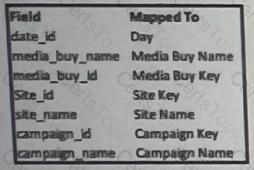
Please note:
• All other measurements were mapped as well to the appropriate fields.
• No other mapping manipulations or formulas were implemented.
How many records will the merged table hold?
Which three entities and/or functions can be used in an expression when building a calculated dimension?
An implementation engineer is requested to create the harmonization field - Magician
This field should come from multiple Twitter Ads data streams, and should follow the below logic:
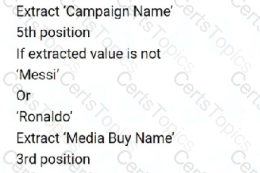
Using the Harmonization Center, the engineer created a single Pattern for Campaign Name. What other action should the engineer take to meet the requirements?
An implementation engineer has been asked to perform QA for a standard file ingestion, done by the client.
The source file that was ingested can be seen below:

The number of rows added to this data stream is 3. What could have led to this discrepancy?
A client's data consists of three data streams as follows:
Data Stream A:

The data streams should be linked together through a parent-child relationship.
Out of the three data streams, Data Stream C is considered the source of truth for both the dimensions and measurements.
The client would like to have a "Site Revenue" measurement.
This measurement should return the highest revenue value per Site, for example:
For Site Key ‘SK_C_2’, the "Site Revenue" should be $7.00.
When aggregated by date, the "Site Revenue" measurement should return the total sum of the results of all sites.
For example:
For the date 1 Apr 2020, "Site Revenue" should be $11.00 (sum of Site Revenue for Site Keys ‘SK_C_1' ($4.00) and ‘SK_C_2’ ($7.00))
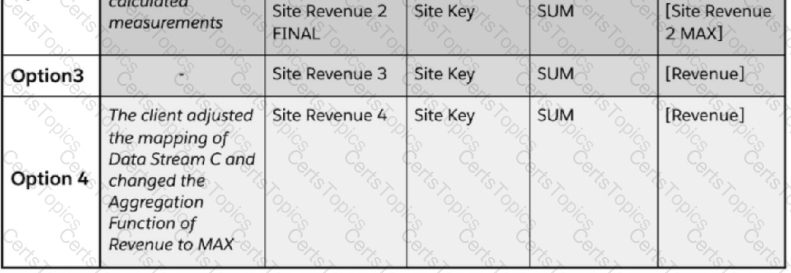
Which options will yield the desired result;
An implementation engineer has been asked to perform a QA for a newly created harmonization field, Color, implemented by a client.
The source file that was ingested can be seen below:

The client performed the below standard mapping:
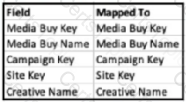
As a final step, the client had created the field ‘Color’. As can be seen, it is extracted from the Creative Name (after the ‘#’ sign).
For QA purposes, you have queried a pivot table, with the following fields:
* Media Buy Key
* Media Buy Name
* In View Impressions
The final pivot is presented below:

An implementation engineer is requested to extract the first three-letter segment of the Campaign Name values.
For example:
Campaign Name: AFD@Mulop-1290
Desired outcome: AFD
Other examples:

Which formula will return the desired values?
Which three statements accurately describe the different data stream types in Marketing Cloud intelligence?
A client's data consists of three data streams as follows:

* The data streams should be linked together through a parent-child relationship.
* Out of the three data streams, Data Stream C is considered the source of truth for both the dimensions and measurements.
Which data stream should be set as a parent?
An implementation engineer is requested to apply the following logic:

To apply the above logic, the engineer used only the Harmonization Center, without any mapping manipulations. What is the minimum amount of Patterns creating both ‘Platform’ and ‘Line of Business’?"
A client wants to integrate their data within Marketing Cloud Intelligence to optimize their marketing Insights and cross-channel marketing activity analysis. Below are details regarding the different data sources and the number of data streams required for each source.
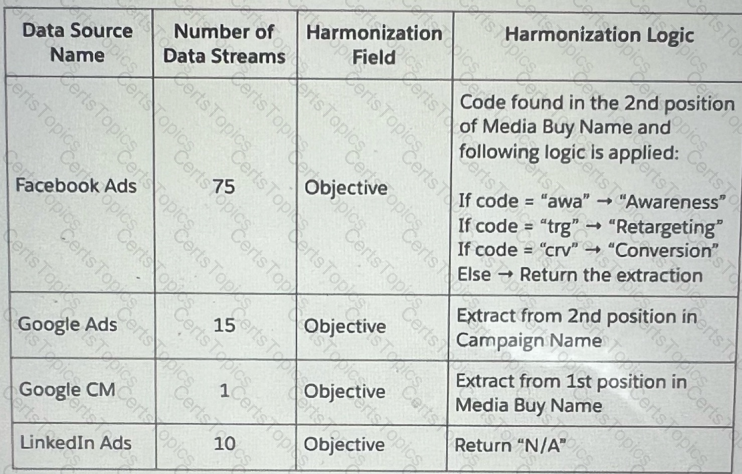
Which three advantages does a client gain from using Calculated Dimensions as the harmonization method for creating the Objective field?
Your client would like to create a new harmonization field - Exam Topic.
The below table represents the harmonization logic from each source.
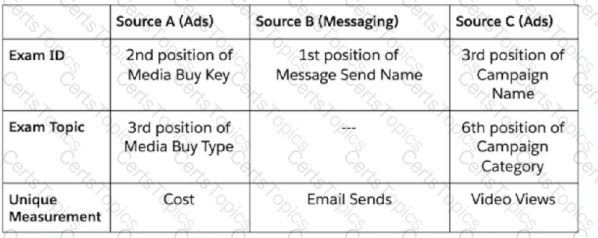
As can be seen from the table, there are in fact two fields that hold a certain connection: Exam ID and Exam Topic. The connection indicates that
where an Exam ID is found - a single Exam Topic value is associated with it.
The client has a requirement to be able to view measurements from all data sources sliced by Exam Topic values, as seen in the following
example:

The client suggested to create, without any mapping manipulations, several patterns via the harmonization center that will generate two
Harmonized Dimensions:
Exam ID
Exam Topic
Given the above information, which statement is correct regarding the ability to implement this request with the above suggestion?
A client's data consists of three data streams as follows:
Data Stream A:
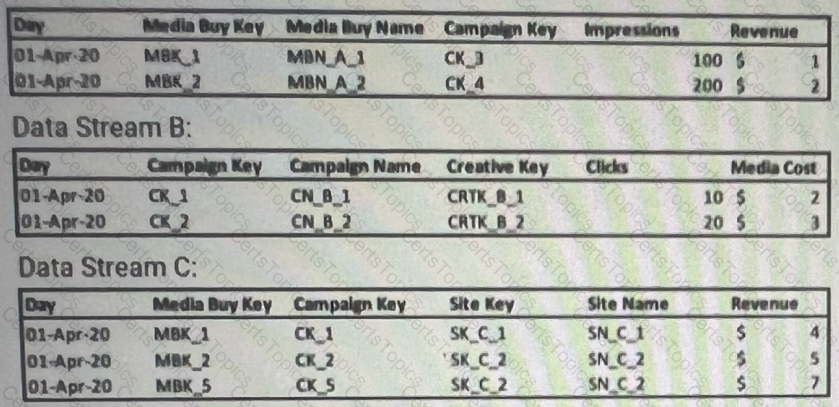
A technical architect is provided with the logic and Opportunity file shown below:
The opportunity status logic is as follows:
For the opportunity stages “Interest”, “Confirmed Interest” and “Registered”, the status should be “Open”.
For the opportunity stage “Closed”, the opportunity status should be closed Otherwise, return null for the opportunity status.
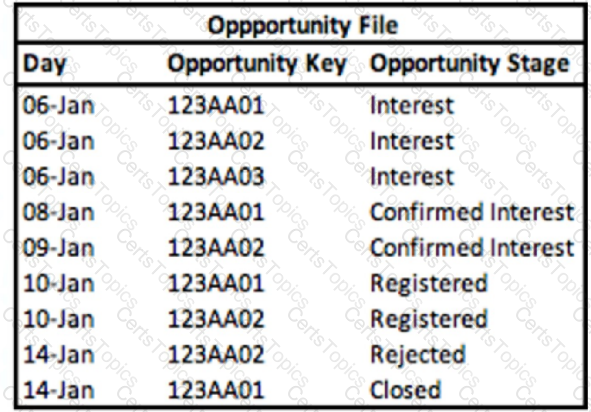
Given the above file and logic and assume that the file is mapped in the OPPORTUNITIES Data Stream type with the following mapping:
“Day” — “Created Date”
“Opportunity Key” + Opportunity Key
“Opportunity Stage” — Opportunity Stage
A pivot table was created to present the count of opportunities in each stage. The pivot table is filtered on Jan 11th. What is the number of ‘opportunities in the Confirmed Interest stage?
A client has integrated data from Facebook Ads. Twitter ads, and Google ads in marketing Cloud intelligence. For each data source, the source, the data follows a naming convensions as …
Facebook Ads Naming Convention - Campaign Name:
CampID_CampName#Market_Object#object#targetAge_TargetGender
Twitter Ads Naming Convention- Media Buy Name
MarketTargeAgeObjectiveOrderID
Google ads Naming Convention-Media Buy Name:
Buying_type_Market_Objective
The client wants to harmonize their data on the common fields between these two platforms (i.e. Market and Objective) using the Harmonization Center. Given the above information, which statement is correct regarding the ability to implement this request?
wet Me - Given the above information, which statement i 's Correct regarding the ability to implement this request?
A client has integrated the following files:
File A:

File B:

The client would like to link the two files in order to view the two KPIs (‘Tasks Completed’ and ‘Tasks Assigned) alongside ‘Employee Name’ and/or
‘Squad’.
The client set the following properties:
+ File A is set as the Parent data stream
* Both files were uploaded to a generic data stream type.
* Override Media Buy Hierarchies is checked for file A.
* The ‘Data Updates Permissions’ set for file B is ‘Update Attributes and Hierarchy’.
When filtering on the entire date range (1-30/8), and querying employee ID, Name and Squad with the two measurements - what will the result look like?
A)

B)

C)

D)
